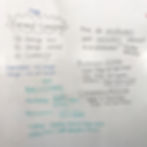Cereal Research
The Clubhouse and Paige's group kicked off the Quarter 4 theme by examining the essential question, "What is the relationship between producers and consumers?" They began by questioning the definition of the terms "producer" and "consumer" and observed various ways the two terms have a relationship. Students connected "producer" with the idea of being an author or creator and "consumer" with the idea of being an audience member or a customer.

On Monday, students were excited to explore the cereal aisle inside the local Ralph's grocery store. They began with a Q and A with the store manager Jonathan, where students asked, "Why don't you put the same amount of each cereal on the shelf?" and "How do you decide where to put each type of cereal?" As they collected our data, students thought critically about how different types of cereal were marketed. O.D. noted that even the cereals who advertised themselves as being healthy still chose to market cereals separately to kids by using tools like cartoons and creative names. Ultimately, it was beneficial for students to begin forming their ideas about cereal branding and marketing in an authentic environment.

However, the excitement didn't end with the field trip to Ralph's! On Tuesday, they actually got to sample cereal to conduct product testing! The goal was for students to engage in full sensory observations about the different types of cereals, both healthy and more sugary. Students used various descriptors to observe what they smell like, look like, and feel like, in addition to tasting a piece or two.

Using this data, as well as the data collected during the field trip, students began analyzing how to be conscious consumers and how make thoughtful observations about the ways products are marketed to them. Many students noted that the sugar content was higher in the cereal marketed to kids, but also deceivingly high in the cereal that is marketed as being more healthy. They also noted that the serving sizes were much smaller than they thought they would be, indicating that the amount of sugar they would ingest would likely be higher. In the end, we hope that these observations and conclusions will help students have more agency in their decisions about what they put in their bodies.
Paige’s Group’s Week at a Glance
Communication Literacy
Book groups
- fluency and intonation
- making predictions
- identifying figurative language
- identifying author's voice
Typing Club
Persuasive paragraph structure
Editing work for punctuation and run-on sentences
Comparing the differences between biographies and autobiographies
Patterns & Modeling
Data collection
Introduction to spreadsheets and using them to analyze data
Introduction to mode, range, minimum, and maximum in a number set; presenting a number set in a number line
Theme
Field trip to Ralph's to collect data on cereal brands and how they are marketed in stores
Defining the terms "producer", "consumer", "marketing", and "stereotypes"
Sensory observations and testing of cereal
Analysis of commercials where cereals are marketed to kids
Misc
Introduction to digital literacy and personal responsibility for internet use
Body Systems: an introduction to the skeletal system
Teaching the basics of 3D design and Tinkercad to Emmarose's group
…............................................................................................................................................................................................
Clubhouse Week at a Glance
Communications Literacy
Continued writing rough drafts for "I Survived a Blackout" pieces.
Peer editing - What do we look for when editing a piece of writing?
Typing final drafts in Google Docs
Book Groups - summarizing, fluency, intonation, proper pronunciation of unknown words
Pictionary Prefix Review -
Creating words using the prefixes
Playing Pictionary on teams
Discussion of the meanings of each prefix and how words are created using prefixes
Plans to begin studying roots of words
Patterns & Modeling
Data collection from Ralph's field trip
Introduction to Google Sheets for organizing and analyzing their data.
Introduction to mode, range, minimum, and maximum in a number set; presenting a number set in a number line
Presenting a number set in a number line
Theme
Field trip to Ralph's to collect data on cereal brands and how they are marketed in stores
Defining the terms "producer", "consumer", "marketing", and "stereotypes"
Sensory observations and testing of cereal
Analysis of commercials where cereals are marketed to kids
Introduction to digital literacy - considering personal responsibility as a good digital citizen


















